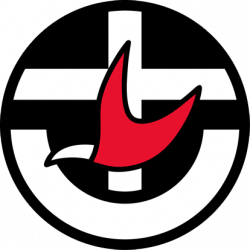St. Luke’s history dates back to 1853 when the first Wesleyan church services were held in homes in the small farming community of Highton. In October 1854, at the present site, the foundation stone of the first brick church was laid and services were being held there by early 1855. The gothic church, these days known as the chapel, was built in 1868 from Ceres sandstone, carted free by farmers from McCann’s quarry. A stone Sunday school followed in 1873 partly funded by potato crops grown in the grounds as well as trees for sale and firewood. The Wesleyan tea meetings were a highlight for the local community.
In 1902 the Wesleyans joined with five other churches in Victoria to form the Methodist Church of Australasia.
The Highton Methodist Church was growing post-WW1, so the Lane Memorial [kindergarten] hall was built beside the church in 1926, finished just days before a tornado swept through Highton on 22nd July, practically demolishing the church. Services were held in the Lane Hall until the church was restored a year later. The congregation of St. John’s, Highton, also worshipped in the hall until their damaged church was rebuilt.
By the mid-1950s Highton had developed from a semi-rural community into a suburb with many new families. The first resident minister was called, and a parsonage was built in Barrabool Road in 1960. The Pre School centre was built in 1964 followed by the hall in 1965.
The Highton Presbyterians held their first services in the Highton hall in February, 1960. An all-purpose church hall in Roslyn road was built in 1960 followed by the manse in 1964 and the Sunday school hall in 1966.
Co-operation developed further between 1972 and 1976 with the formation of the Highton-Barrabool Hills parish which included the congregations of the Barrabool Presbyterian Church and the Ceres Methodist Church. The name of St. Luke’s was chosen in 1974 to represent all combined Highton church organisations. In 1977 the congregations welcomed the advent of the Uniting Church in Australia. However In 1999, however Synod decreed that individual church councils would replace parish councils, thus ending a long productive association with the Hills congregations.
Co-operation developed further between 1972 and 1976 with the formation of the Highton-Barrabool Hills parish which included Barrabool Presbyterian Church and the Ceres Methodist Church. The name of St. Luke’s was chosen in 1974 to represent all combined Highton church organisations. In 1977 the congregations welcomed the advent of the Uniting Church in Australia. When parish councils were replaced with individual church councils in 1999, the long productive association with the Hills congregations ended.
All activities were consolidated on the larger site in Barrabool Road in 1980 and the Roslyn Road property was sold to the South Barwon Council in 1982. A new worship centre was built on the Barrabool road site in 1983.
We give thanks to God that the St. Luke’s church complex is truly a welcoming multicultural church providing worship, mission, teaching, outreach and pastoral care, together with diverse community activities catering for all age groups.
Reference – “Steadfast through Change” – a history of the Wesleyan- Methodist Uniting Church in Highton from 1853 to 2006.


